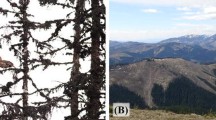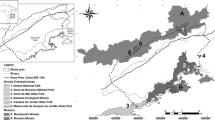Abstract
For many species, one important key to persistence is maintaining connectivity among local populations that allow for dispersal and gene flow. This is probably true for carabid species (Coleoptera:Carabidae) living in the fragmented forests of the Bereg Plain (NE Hungary and W Ukraine). Based on field data, we have drafted a landscape graph of the area representing the habitat network of these species. Graph nodes and links represented two kinds of landscape elements: habitat (forest) patches and corridors, respectively. The quality of habitat patches and corridors were ranked (from low (1) to high (4)), reflecting local population sizes in the case of patches and estimated permeability in the case of corridors. We analysed (1) the positional importance of landscape elements in maintaining the connectivity of the intact network, (2) the effect of inserting hypothetical corridors into the network, (3) the effects of improving the quality of the existing corridors, and (4) how to connect every patch in a cost-effective way. Our results set quantitative priorities for conservation practice by identifying important corridors: what to protect, what to build and what to improve. Several network analytical techniques were used to account for the directed (source-sink) and highly fragmented nature of the landscape graph. We provide conservation priority ranks for the landscape elements and discuss the conditions for the use of particular network indices. Our study could be of extreme relevance, since a new highway is being planned through the area.




Similar content being viewed by others
References
Baum KA, Haynes KJ, Dillemuth FP, Cronin RT (2004) The matrix enhances the effectiveness of corridors and stepping stones. Ecology 85:2671–2676
Baudry J, Burel F, Aviron S, Martin M, Ouin A, Pain G, Thenail C (2003) Temporal variability of connectivity in agricultural landscapes: do farming activities help? Landsc Ecol 18:303–314
Baudry J, Burel F (2004) Trophic flows and spatial heterogeneity in agricultural landscapes. In: Polis GA, Power ME, Huxel GR (eds) Food webs at the landscape level. University of Chicago Press, Chicago, pp 317–332
Beier P, Noss RF (1998) Do habitat corridors provide connectivity? Conserv Biol 12:1241–1252
Berggren A, Birath B, Kindvall O (2002) Effect of corridors and habitat edges on dispersal behavior, movement rates, and movement angles in Roesel’s bush-cricket (Metrioptera roeseli). Conserv Biol 16:1562–1569
Borgatti SP (2003) The key player problem. In: Breiger R, Carley K, Pattison P (eds) Dynamic Social Network Modeling and Analysis: Workshop Summary and Papers, Committee on Human Factors, National Research Council, pp 241–252
Briers RA (2002) Incorporating connectivity into reserve selection procedures. Biol Conserv 103:77–83
Brooks TM, Pimm SL, Oyugi JO (1999) Time lag between deforestation and bird extinction in tropical forest fragments. Conserv Biol 13:1140–1150
Brose U (2003a) Island biogeography of temporary wetland carabid beetle communities. J Biogeogr 30:879–889
Brose U (2003b) Bottom-up control of carabid beetle communities in early successional wetlands: mediated by vegetation structure or plant diversity? Oecologia 135:407–413
Burel F (1989) Landscape structure effects on carabid beetles spatial patterns in western France. Landsc Ecol 4:215–226
Burel F (1992) Effect of landscape structure and dynamics on species diversity in hedgerow networks. Landsc Ecol 6:161–174
Cantwell MD, Forman RTT (1993) Landscape graphs: ecological modelling with graph theory to detect configurations common to diverse landscapes. Landsc Ecol 8:239–255
Collinge SK (2000) Effects of grassland fragmentation on insect species loss, colonization, and movement patterns. Ecology 81:2211–2226
Crooks KR, Soulé ME (1999) Mesopredator release and avifaunal extinctions in a fragmented system. Nature 400:563–566
Davies KF, Margules CR, Lawrence JF (2000) Which traits of species predict population declines in experimental forest fragments? Ecology 81:1450–1461
de la Pena NM, Butet A, Dlettre Y, Morant P, Burel F (2003) Landscape context and carabid beetles (Coleoptera:Carabidae) communities of hedgerows in western France. Agric Ecosyst Environ 94:59–72
Étienne RS (2004) On optimal choices in increase of patch area and reduction of interpatch distance for metapopulation persistence. Ecol Modell 179:77–90
Haddad NM, Browne DR, Cunningham A, Danielson BJ, Levey DJ, Sargent S, Spira T (2003) Corridor use by diverse taxa. Ecology 84:609–615
Henein K, Merriam G (1990) The elements of connectivity where corridor quality is variable. Landsc Ecol 4:157–170
Ishitani M, Kotze DJ, Niemelä J (2003) Changes in carabid beetle assemblages across an urban-rural gradient in Japan. Ecography 26:481–489
Jordán F (2000) A reliability-theory approach to corridor design. Ecol Modell 128:211–220
Jordán F, Báldi A, Orci KM, Rácz I, Varga Z (2003) Characterizing the importance of habitat patches and corridors in maintaining the landscape connectivity of a Pholidoptera transsylvanica (Orthoptera) metapopulation. Landsc Ecol 18:83–92
Keitt TH, Urban DL, Milne BT (1997) Detecting critical scales in fragmented landscapes. Conserv Ecol 1(1):4
Keller I, Largiadér CR (2003) Recent habitat fragmentation caused by major roads leads to reduction of gene flow and loss of genetic variability in ground beetles. Proc Roy Soc Lond, Ser B 270:417–423
Kondoh M (2003) Habitat fragmentation resulting in overgrazing by herbivores. J Theor Biol 225:453–460
Kotze DJ, Niemelä J, O’Hara RB, Turin H (2003) Testing abundance-range size relationships in European carabid beetles (Coleoptera, Carabidae). Ecography 26:553–566
Ködöböcz V, Magura T (2005) Forests of the Bereg-plain as refuges based on their carabid fauna (Coleoptera:Carabidae). Acta Phytopathologica et Entomologica Hungarica 40:367–382
Kruess A, Tscharntke T (1994) Habitat fragmentation, species loss, and biological control. Science 264:1581–1584
Lövei GL, Sunderland KD (1996) Ecology and behavior of ground beetles (Coleoptera:Carabidae). Annu Rev Entomol 41: 231–256
Lövei GL, Magura T, Tóthmérész B, Ködöböcz V (2006) The influence of matrix and edges on species richness patterns of ground beetles (Coleoptera, Carabidae) in habitat islands. Glob Ecol Biogeogr 15: 283–289
Magura T, Tóthmérész B, Molnár T (2000) Spatial distribution of carabid species along a grass-forest transects. Acta Zoologica Academiae Scientiarium Hungariae 46:1–17
Magura T, Tóthmérész B, Molnár T (2001a) Forest edge and diversity: carabids along forest-grassland transects. Biodiv Conserv 10:287–300
Magura T, Ködöböcz V, Tóthmérész B (2001b) Effects of habitat fragmentation on carabids in forest patches. J Biogeogr 28:129–138
Magura T, Tóthmérész B, Molnár T (2004) Changes in carabid beetle assemblages along an urbanisation gradient in the city of Debrecen, Hungary. Landsc Ecol 19:747–759
Niemelä J, Kotze DJ, Venn S, Penev L, Stoyanov I, Hartley D, Montes de Oca E (2002) Carabid beetle assemblages (Coleoptera, Carabidae) across urban-rural gradients: an international comparison. Landsc Ecol 17:387–401
O`Neill RV, Krummel JR, Gardner RH, Sugihara G, Jackson B, DeAngelis DL, Milne BT, Turner MG, Zygmunt B, Christensen SW, Dale VH, Graham RL (1998) Indices of landscape pattern. Landsc Ecol 1:153–162
Pascual-Hortal L, Saura S (2006) Comparison and development of new graph-based landscape connectivity indices: towards the prioritization of habitat patches for conservation. Landsc Ecol 21: 959–967
Pickett STA, Cadenasso ML (1995) Landscape ecology: spatial heterogeneity in ecological systems. Science 269:331–334
Schumaker NH (1996) Using landscape indices to predict habitat connectivity. Ecology 77:1210–1225
Selonen V, Hanski IK (2003) Movements of the flying squirrel Pteromys volans in corridors and in matrix habitat. Ecography 26:641–651
Shimazaki H, Tamura M, Darman Y, Andronov V, Parilov MP, Nagendran M, Higuchi H (2004) Network analysis of potential migration routes for oriental white storks (Ciconia boyciana). Ecol Res 19:683–698
Spiller DA, Schoener TW (1998) Lizards reduce spider species richness by excluding rare species. Ecology 79:503–516
Suominen O, Niemelä J, Martikainen P, Niemelä P, Kojola I (2003) Impact of reindeer grazing on ground-dwelling Carabidae and Curculionidae assemblages in Lapland. Ecography 26:503–513
Tewksbury JJ, Levey DJ, Haddad NM, Sargent S, Orrock JL, Weldon A, Danielson BJ, Brinkerhoff J, Damschen EI, Townsend P (2002) Corridors affect plants, animals, and their interactions in fragmented landscapes. Proc Nat Acad Sci, USA 99:12923–12926
Thiele HU (1977) Carabid beetles in their environments. Springer Verlag, New York
Tischendorf L, Wissel C (1997) Corridors as conduits for small animals: attainable distances depending on movement pattern, boundary reaction and corridor width. Oikos 79:603–611
Tischendorf L, Irmler U, Hingst R (1998) A simulation experiment on the potential of hedgerows as movement corridors for forest carabids. Ecol Modell 106:107–118
Tischendorf L, Fahrig L (2000a). On the usage and measurement of landscape connectivity. Oikos 90:7–19
Tischendorf L, Fahrig L (2000b) How should we measure landscape connectivity? Landsc Ecol 15:633–641
Turner MG, Gardner RH, O’Neill RV (2001) Landscape ecology. Springer Verlag, Berlin
Urban D, Keitt T (2001) Landscape connectivity: a graph-theoretic perspective. Ecology 82:1205–1218
Verboom J, Foppen R, Chardon P, Opdam P, Luttikhuizen P (2001) Introducing the key patch approach for habitat networks with persistent populations: an example for marshland birds. Biol Conserv 100:89–101
Wassermann S, Faust K (1994) Social network analysis. Cambridge University Press, Cambridge
Acknowledgements
We are grateful for Zoltán Peresztegi-Nagy for developing a computer programme for one part of the analysis, András Báldi and Gábor Lövei for useful discussions and three anonymous reviewers for their comments on the manuscript. We thank K. Csepi and G. Lövei for linguistic revision. FJ and TM were supported by grants from the Hungarian Scientific Research Fund (OTKA T 37726 and F 61651, respectively). FJ was also supported by Society in Science: the Branco Weiss Fellowship from ETH Zürich, Switzerland.
Author information
Authors and Affiliations
Corresponding author
Rights and permissions
About this article
Cite this article
Jordán, F., Magura, T., Tóthmérész, B. et al. Carabids (Coleoptera: Carabidae) in a forest patchwork: a connectivity analysis of the Bereg Plain landscape graph. Landscape Ecol 22, 1527–1539 (2007). https://doi.org/10.1007/s10980-007-9149-8
Received:
Accepted:
Published:
Issue Date:
DOI: https://doi.org/10.1007/s10980-007-9149-8




